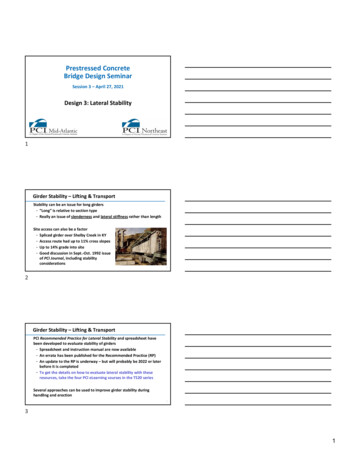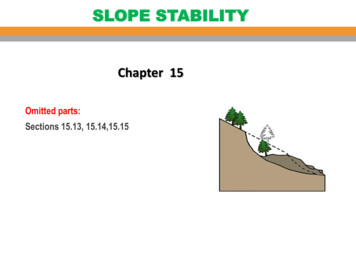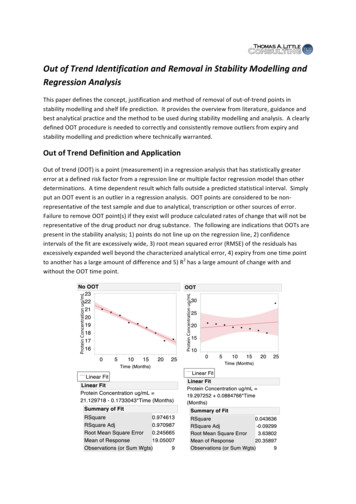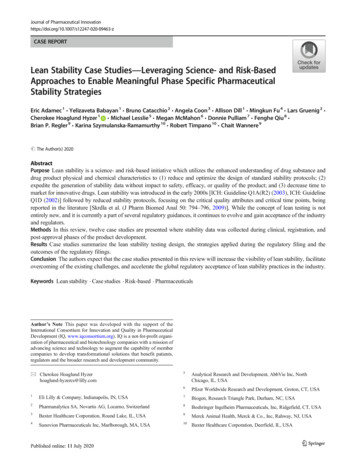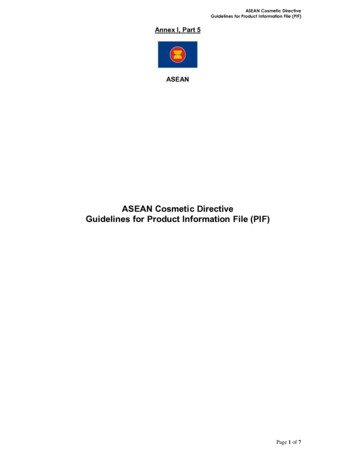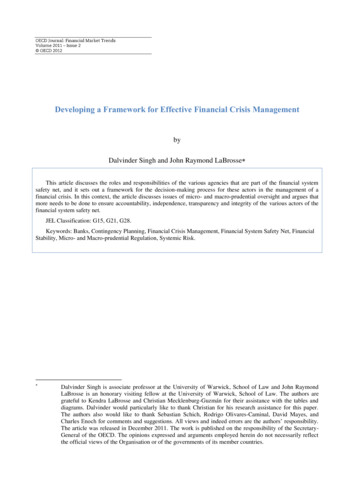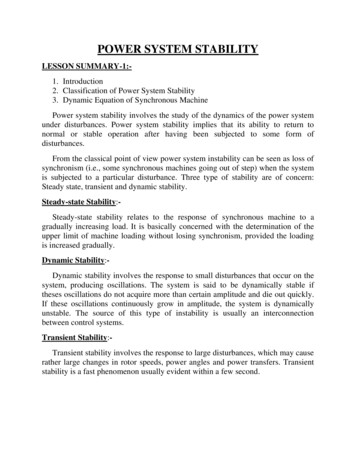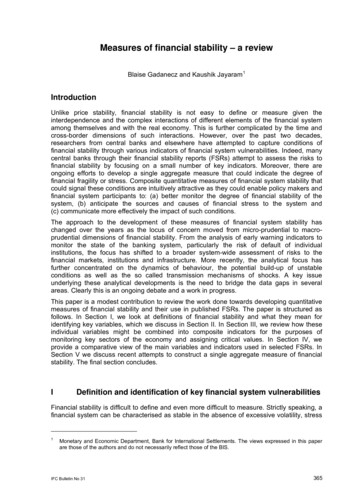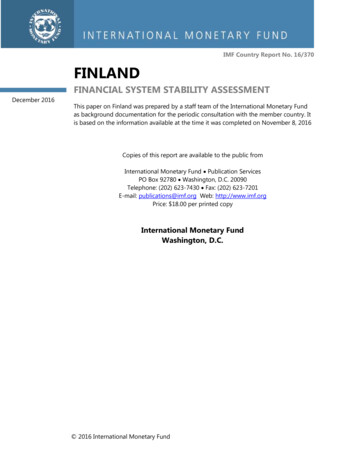
Transcription
IMF Country Report No. 16/370FINLANDFINANCIAL SYSTEM STABILITY ASSESSMENTDecember 2016This paper on Finland was prepared by a staff team of the International Monetary Fundas background documentation for the periodic consultation with the member country. Itis based on the information available at the time it was completed on November 8, 2016Copies of this report are available to the public fromInternational Monetary Fund Publication ServicesPO Box 92780 Washington, D.C. 20090Telephone: (202) 623-7430 Fax: (202) 623-7201E-mail: publications@imf.org Web: http://www.imf.orgPrice: 18.00 per printed copyInternational Monetary FundWashington, D.C. 2016 International Monetary Fund
FINLANDFINANCIAL SYSTEM STABILITY ASSESSMENTNovember 8, 2016Approved ByJames Morsink andMahmood PradhanPrepared ByMonetary and CapitalMarkets DepartmentThis report is based on the work of the FinancialSector Assessment Program (FSAP) missions thatvisited Finland and Frankfurt during March 28–April 14 and June 14–30, 2016. The FSAP findingswere discussed with the authorities during theArticle IV consultation mission in September 2016. The FSAP team was led by Marco Piñón and included Peter Breuer (deputy missionchief), Atilla Arda, Nathaniel Arnold, Chikako Baba, Kay Chung, Pierpaolo Grippa, EijaHolttinen, Cyril Pouvelle, Nadine Schwarz, Sabine Tuzik, and Javier Ochoa (all IMFstaff), as well as Jonathan Fiechter, Mindaugas Leika, and Rodney Lester (externalexperts). The mission met Permanent Secretary and other staff of the Ministry ofFinance (MoF), the Governor of the Bank of Finland (BoF) and his staff, the DirectorGeneral of the Finnish Financial Supervisory Authority (FIN-FSA) and her staff,management and staff of the European Central Bank (ECB), representatives of banks,insurance companies, and other financial institutions, industry associations, policyresearch organizations, and auditors. FSAPs assess the stability of the financial system as a whole and not that ofindividual institutions. They are intended to help countries identify key sources ofsystemic risk in the financial sector and implement policies to enhance its resilienceto shocks and contagion. Certain categories of risk affecting financial institutions,such as operational or legal risk, or risk related to fraud, are not covered in FSAPs. Finland is deemed by the Fund to have a systemically important financial sector andthe stability assessment under this FSAP is part of bilateral surveillance under ArticleIV of the Fund’s Articles of Agreement. This report was prepared by Messrs. Marco Piñón and Peter Breuer with inputs fromthe Finland FSAP team members.
FINLANDCONTENTSGlossary 4EXECUTIVE SUMMARY 6KEY RECOMMENDATIONS 8MACROFINANCIAL SETTING 9A. Macroeconomic Setting 9B. Structure of the Financial System 9RISKS AND VULNERABILITIES 17A. Key Macrofinancial Risks 17B. Banks 19C. Non-banks 28FINANCIAL STABILITY POLICY FRAMEWORK 30A. Banking Supervision 30B. Branchification 31C. Non-Bank Supervision 33D. Macroprudential Policy Framework 34E. Anti-Money Laundering/Countering the Financing of Terrorism 35CONTINGENCY PLANNING AND CRISIS MANAGEMENT 36BOXThe Impact of Nordea’s Change in Legal Structure in Finland 32FIGURES1. Macroeconomic Developments 102. Credit Gap: Trend Deviation of Credit to Private Non-financial Sector 123. Sectoral External Net Asset Positions, 2015 124. Structure of the Banking Sector 145. Banking Sector: Funding structure 166. Deposit taking institutions balance sheet 2015 177. Banking Sector: Cross-border Exposure 188. Internal Ratings-Based Approach and Risk-Weighted Assets 209. Selected Countries: Financial Soundness Indicators, 2015 222INTERNATIONAL MONETARY FUND
FINLAND10. Macroeconomic Baseline and Stress Scenarios 2311. Scenario Severity from a Historical Perspective 2412. Solvency Stress Test Results in the Three Scenarios 2513. LCR-based stress test results 2614. Credit Risk: Cross-border Claims to Three Other Nordic Countries 2715. Funding Risk: Cross-border Linkages with the 3 Other Nordic Countries 2816. Linkages with the Nordic Region 2817. Employment Based Pension Funds’ Cash Flow 2918. EIOPA Risk-free Rate Yield Curve 30TABLES1. Key Recommendations 82. Selected Economic Indicators, 2012-2021 113. Inter-sectoral Financial Assets and Liabilities Positions, 2015 134. Structure of the Financial System 155. Financial Soundness Indicators 216. Results of the TD Solvency Stress in the 3 Scenarios 247. Summary of the Liquidity Stress Test Results 26APPENDICES1. Risk Assessment Matrix 382. Banking Sector Stress Testing Matrix (STeM) 393. Status of the Recommendations of the 2010 FSAP 42INTERNATIONAL MONETARY FUND3
FINLANDGlossaryABSAsset-Backed SecuritiesAML/CFTAnti-Money Laundering and Combating the Financing of TerrorismBasel IBasel IIInternational Convergence of Capital Measurement and Capital Standards (July 1988)International Convergence of Capital Measurement and Capital Standards: A RevisedFramework – Comprehensive Version (June 2006)A global regulatory framework for more resilient banks and banking systems (revisedversion June 2011)Basel IIIBCPBasel Core PrinciplesBoFBank of FinlandCARCapital Adequacy RatioCCPsCET1CPCMCRDCRRCSEsCentral CounterpartiesCommon Equity Tier 1Contingency Planning and Crisis ManagementCapital Requirements DirectiveCapital Requirements RegulationCovered Swap EntitiesDGSDeposit Guarantee SchemeEADEBAExposure at DefaultEuropean Banking AuthorityECEuropean CommissionECBEEAEuropean Central BankEuropean Economic AreaEIOPAEuropean Insurance and Occupational Pensions AuthorityELAEmergency Liquidity AssistanceESRBEUFATFFFSAFIAFIN-FSAEuropean Systemic Risk BoardEuropean UnionFinancial Action Task ForceFinnish Financial Stability AuthorityFinancial Institutions ActFinnish Financial Supervisory AuthorityFSAPFinancial Sector Assessment ProgramFMIFinancial Market InfrastructureFSIFinancial Soundness IndicatorFSSAFinancial System Stability AssessmentG-SIBGlobally Systemically Important BankHPIOSCOHodrick-Prescott filterInternational Organization of Securities Commissions4INTERNATIONAL MONETARY FUND
FINLANDIRBLCRLGDLSIsLTVMoFInternal Ratings Based approachLiquidity Coverage RatioLoss Given DefaultLess Significant InstitutionsLoan to ValueMinistry of FinanceMoUMemorandum of UnderstandingNBABNBFNBSGNCANFCNPLNSFRNordea Bank ABNordea Bank FinlandNordic-Baltic Stability GroupNational Competent AuthorityNon-financial CorporationNonperforming loanNet Stable Funding RatioOECDOrganization for Economic Cooperation and DevelopmentOTCPDOver the CounterProbability of defaultROEReturn on EquityRWASCRSIFISRBRisk-Weighted assetSolvency II Capital RequirementsSystemically Important Financial InstitutionSystemic-Risk BufferSSMSingle Supervisory MechanismTRIMTargeted Review of Internal ModelsWEOWorld Economic OutlookINTERNATIONAL MONETARY FUND5
FINLANDEXECUTIVE SUMMARYNotwithstanding the three-year recession, Finland’s banking system remains well capitalizedand profitable. While low interest rates have squeezed net interest income, banks have increasedincome from trading and insurance, and reduced cost-income ratios, helping to maintainprofitability. Nonperforming loans have remained low and capitalization ratios are well aboverequirements, though buffers may be exaggerated by the aggressive use of risk weights. The NetStable Funding Ratio suggests that vulnerabilities from maturity mismatches are limited inaggregate.Nevertheless, previously identified vulnerabilities remain and some have increased. Thebanking system remains largely reliant on external wholesale funding. Social safety nets have helpedprotect disposable income in recent years, and thus the financial sector through households’ debtservicing capacity. Fiscal buffers, however, have been eroded, and households’ rising debt levelsmake them more vulnerable to income and interest shocks. Keys macrofinancial risks include alackluster recovery from the domestic recession, adverse macroeconomic or financial shocks in aNordic country, and a sharp growth slowdown in advanced economies, in particular the euro area.Stress tests suggest that banks are largely resilient to solvency shocks but exposed to liquidityshocks. While risk-weighted capital ratios would remain above regulatory minima under a severemacroeconomic stress scenario, unweighted leverage ratios would fall below the hurdle rate. Asevere disruption in external wholesale funding or in the covered bond market could lead to systemicliquidity shortfalls.The authorities are encouraged to ensure that adequate bank capital and liquidity cushionsare maintained. The Finnish authorities should pursue their plan to set risk weight floors formortgages and the ECB should proceed with its comprehensive review of banks’ internal riskmodels, and reinforce their ongoing monitoring. In case of emerging imbalances, the authoritiesshould ensure adequate liquidity cushions are maintained.Supervisory financial and human resources need to be augmented and the regulatoryauthorities adequately empowered to be up to the challenges of the new regulatoryenvironment. Bank and non-bank supervision, macroprudential policy making and contingencyplanning have become more intense, intrusive, and resource-intensive. This has stretched thesupervisory resources of the Finnish Financial Supervisory Authority (FIN-FSA) and the FinnishFinancial Stability Authority (FFSA), which will also need to keep pace with the demands of thebroader global regulatory reforms. In addition, the FIN-FSA needs to be granted the powers tocredibly enforce supervisory action. Moreover, the legal and operational framework for legalprotection of officials, staff, and agents of the agencies should be strengthened.In light of Nordea Finland’s likely conversion to a branch, the authorities should conclude themultilateral supervisory MoU under negotiation with the Sweden’s Financial SupervisionAgency and other supervisors in the region. This should provide a basis within existing EU6INTERNATIONAL MONETARY FUND
FINLANDregulations to strengthen the role of host supervisors of systemically important bank branches.Nordea will remain systemically important in Finland even after its Finnish banking subsidiary isconverted into a branch, with nearly one third of domestic deposits. The ease with which liquiditycan be transferred across borders within banking groups poses a particular concern for Finland.While the Finnish authorities (and ECB) will remain members of the supervisory college, directsupervision of the Finnish banking operations of Nordea will be transferred to Sweden. When abranch is of systemic importance in a host country (i.e., the disorderly failure of the bank would beexpected to have systemic repercussions on the host country’s financial system and financialstability), consideration should be given in future revisions of CRD IV to provide for enhancedsupervisory powers for the host country supervisors, in close coordination with the home countrysupervisor. The objective of such revisions would be to facilitate the host country’s understanding ofthe risks posed by the branch and to enable it to take actions to promote the resilience andresolvability of the branch.The prolonged period of low interest rates has heightened risks in the non-bank financialsector. Although the life insurance sector has moved towards unit-linked products, policies withimplied guaranteed rates substantially above current interest rates still comprise up to 40 percent ofinsurer’s technical provisions. Moreover, solvency is depressed by the low risk free rates used asdiscount factors to calculate technical provisions and own funds. Likewise, economic anddemographic pressures have prompted pension insurers (the main providers of occupationalpension schemes in Finland) and pension funds to increase the riskiness of their investmentportfolios.Several macroprudential instruments have been formally approved and activated recently,but the toolkit should be expanded and data gaps filled. While the tools currently activatedappear appropriate, the FIN-FSA’s mandate should be broadened beyond tools explicitly approvedin the legislation. In particular, the systemic risk buffer should be made available for activation ifneeded. Also, macroprudential tools based on the terms of loans (such as maximum maturity limit)and borrowers’ eligibility (such as a cap on the loan-to-income ratio) should be considered. Toeffectively use these measures and enable risk analyses using granular data, a loan registry systemshould be created.Finland’s contingency planning and crisis management (CPCM) framework rests on strongfoundations, but actions are needed to ensure operational capacity to rapidly deploy recoveryand resolution tools. The separation between CPCM functions (supervision, resolution, and liquidityprovision) reduces potential conflicts. This should be complemented by clearly assigning the overallresponsibility to actively oversee crisis preparedness and management at the national and BankingUnion levels. CPCM cooperation among Nordic countries should be strengthened, compensating forthe authorities’ diminished role in resolution planning and decision-making that would followNordea Bank Finland’s conversion to a branch. Resolution planning for systemic banks should beexpedited.INTERNATIONAL MONETARY FUND7
FINLANDKEY RECOMMENDATIONSTable 1. Finland FSAP: Key RecommendationsRecommendations and Responsible AuthoritiesGeneral1.Increase the FIN FSA and FFSA’s financial and human resources in accordance with theincrease in regulatory complexity and supervision intensity in (i) prudential supervision ofbanks (including systemic branches), (ii) prudential supervision of insurers, (iii) contingencyplanning/crisis management, (iv) macroprudential policy analysis, and (v) investment fundsand their managers. (Box 1, ¶30, ¶36, ¶43, ¶44, ¶48, ¶51)2.Expand cooperation arrangements with other Nordic supervisors to include (i) formal regionwide sharing of supervisory data and coordinated inspections, including foreign branches andcross-border management of investment funds, (ii) conduct Nordic stress tests, (iii) strengthencollaboration with macroprudential authorities, and (iv) enhanced CPCM cooperation onsystemically important branches and regular crisis simulation exercises. (¶13, ¶47, ¶44, ¶52)3.Strengthen legal protection for staff of all financial oversight agencies (¶50)Risk Analysis4.Ensure banks’ Internal Ratings Based models are calibrated to reflect severe stress. (¶19)5.Intensify monitoring of banks’ liquidity positions in foreign currencies and crossholdings ofcovered bonds used as collateral. Perform liquidity stress tests for various time horizons andstand ready to take supervisory action if imbalances emerge. (¶23, ¶41)Banking Supervision6.Amend law to grant the FSA full Pillar 2 powers for decisions on capital and liquidityrequirements and other supervisory measures (¶38)7.Ensure effective ongoing monitoring of banks’ internal risk models following the upcomingSSM comprehensive review (TRIM project). (¶40)Macroprudential Policy Framework8.Clearly define a macroprudential policy mandate of the FIN-FSA beyond the measuresapproved in laws. (¶48)9.Create a household loan registry. (¶48)10.Introduce a systemic risk buffer and a loan-to-income limit. (¶48)11.Finalize the plan to introduce floors for the risk-weights used in internal models. (¶48)Contingency Planning and Crisis Management12.Formalize inter-agency cooperation on crisis preparedness and management at the nationallevel, possibly through an expanded mandate for the FFSA Advisory Council (¶51)13.Under the oversight of the FFSA Advisory Council, ensure agency-specific and nationalfinancial crisis planning. (¶51-52)14.Expedite resolution planning for systemic financial institutions. (¶52)15.Define strategies for liquidity assistance to banks in resolution and introduce anindemnification arrangement for ELA losses if incurred by the BoF. (¶51)Non-banks16.Upgrade legislation to cover the supervisory actions and any other measures required in theevent of pension insurer or fund distress and if resolution becomes necessary. (¶42)17.Ensure adequacy of action plans for life insurers to meet Solvency II requirements, includingby conducting regular stress testing under adverse scenarios. (¶30)18.Monitor fund managers’ risk management processes, increase the use of supervisory data toanalyze risks, and improve FIN-FSA’s capability to conduct market surveillance. (¶32)*C continuous; I (immediate) within one year; NT (near term) 1-3 years; MT (medium term) 3-5 years.8INTERNATIONAL MONETARY FUNDTime*I, CNTI, CNTNTNTMTNTNTI, NTIII, CINTINTNT, C
FINLANDMACROFINANCIAL SETTINGA. Macroeconomic Setting1.The economy has emerged from a three-year recession, but the outlook is for a slowand fragile recovery. The decline of the paper industry and the technology company Nokia,exacerbated by weak external, demand contributed to a 3 percent drop in GDP over 2012–14 (Figure1 and Table 2). The fiscal deficit breached the Stability and Growth Pact’s 3 percent of GDP thresholdin 2014, and public debt exceeded 60 percent of GDP in 2015. Growth turned positive in 2015, and isexpected to solidify over the medium term but remain well below its pre-crisis average. Headlineinflation recently turned positive along with rising oil prices, but remains low. The highunemployment rate is projected to slowly fall over the next few years.2.Financial cycle and structural indicators offer a mixed picture. The credit-to-GDP gaphas steadily declined since 2009 and was slightly positive as of end-2015 (Figure 2). Credit to theprivate non-financial sector is at a historic peak (183 percent of GDP), though this is near the OECDmedian. Household debt (including tenant-owned housing company loans) is at 125 percent ofdisposable income, which is a historic high, though below other Nordic countries. In contrast, houseprices have declined slightly since 2013 and standard measures of house price valuation (e.g. priceto-income ratio) do not indicate significant overvaluation.3.Finland’s financial position with the rest of the world is close to balance but there isconsiderable variation across sectors (Figure 3 and Table 3). Banks and non-financial corporations(NFC) are net debtors to the rest of the world, though in the case of NFCs nearly 60 percent of theexternal liabilities are equity. The government is a net creditor to the rest of the world, largely due topension schemes being included as part of the government in the national accounts. Householdsare also net external creditors, largely through institutional investors (e.g. pension funds, insurers,and investment funds).B. Structure of the Financial System4.Finland’s financial system is relatively large with credit institutions constituting thelargest share (Figure 4 and Table 4). The financial systems’ assets were equivalent to about 400percent of GDP in 2015, with banks’ assets of 230 percent of GDP, of which foreign-owned banksassets of 160 percent of GDP. Pension funds, insurance companies, and other financialintermediaries manage assets worth 51, 35 and 72 percent of GDP, respectively.5.There are significant links between some banks and non-bank financial firms. Manynon-banks are part of financial conglomerates. For example, OP Financial Group controls both thelargest domestically-owned bank and the largest non-life insurance company. In other cases,insurance companies have exposures to banks through their equity holdings. For example, SampoGroup controls two of the largest insurance companies in Finland and owns over 20 percent ofNordea, the Swedish bank whose Finnish subsidiary is the largest bank in Finland.INTERNATIONAL MONETARY FUND9
FINLANDFigure 1. Macroeconomic Developments10.0Unemployment Rate( Percent of labor 2009201120132015Inflation(Annual average, percent 015120Household Debt(Percent of disposable 72009201120132015802005Credit to Nonfinancial Corporations( Percent of GDP)2007200920112013Sources. Statistics Finland, IMF WEO, IMF International Financial Statistics, and Fund staff calculations.10INTERNATIONAL MONETARY FUND2015
FINLANDTable 2. Selected Economic Indicators, roj.(Percentage change, unless otherwise indicated)Output and demand (volumes)GDPDomestic demandPrivate consumptionPublic consumptionGross fixed capital formationChange in stocks (contribution to growth in percent of GDP)Exports of goods and servicesImports of goods and servicesNet exports (contribution to growth in percent of ces, costs, and incomeConsumer price inflation (harmonized, average)Consumer price inflation (harmonized, end-year)GDP deflatorUnit labor cost, -0.71.10.01.2Labor marketLabor forceEmploymentUnemployment rate (in percent)Potential output and NAIRUOutput gap (in percent of potential output)1Growth in potential output(Percent of GDP)General government finances2Overall mary balance3Structural balance (in percent of potential .9-1.0-0.7-0.5-0.5-0.1-0.50.5-0.6Structural primary balance (in percent of potential GDP)3Gross 43.4-40.1-37.3-34.8-32.7Net debt4(Percent)Money and interest ratesM3 (Finnish contribution to euro area , growth rate, e.o.p.)Finnish MFI euro area loans (growth rate, e.o.p.)Domestic nonfinancial private sector credit growth (e.o.p.)3-month Euribor rate (percent)10-year government bonds 5.00.94.1.0.7.4.5.4.7.5.0.5.4.5.7.5.8.(Percent of GDP)National saving and investmentGross national savingGross domestic investmentBalance of paymentsCurrent account balanceGoods and services balanceNet international investment positionGross external debtExchange rates (period average)Euro per US Nominal effective rate (appreciation in percent)Real effective rate (appreciation in es: Bank of Finland, BIS, International Financial Statistics, IMF Institute, Ministry of Finance, Statistics Finland, and Fund staff calculations.1A negative value indicates a level of actual GDP that is below potential output.2Fiscal projections include measures as specified in the General Government Fiscal Plan.3Adjusted for interest expenditure.4Defined as the negative of net financial worth (i.e., debt minus assets).5CPI-based real effective exchange rate.INTERNATIONAL MONETARY FUND11
FINLANDFigure 2. Credit Gap: Trend Deviation of Credit to Private Nonfinancial Sector(Percent of GDP)4030Thresholds forcountercyclical capitalbuffer requirement20100-10-20-301985 1988 1991 1994 1997 2000 2003 2006 2009 2012 2015Sources. BIS, Statistics Finland, Bank of Finland, and Fund staff calculations.Note. The indicator has been calculated according to Basel Committee (2010) recommendations using the onesided Hodrick Prescott filter (lambda 400,000).Figure 3. Finland: Sectoral External Net Asset Positions, 2015(Percent of GDP)GovernmentBanks(33%)(-39%)Rest of theWorldDII HHNFCs(39%)(-33%)Sources. Statistics Finland and Fund staff calculations.Notes. Arrows indicate net asset positions (assets minus liabilities) of different Finnish sectors vis-à-vis the Rest ofthe World (direction indicates the direction of the net claim). Numbers in parentheses are the sectoral net assetpositions vis-à-vis the Rest of the World (in percent of 2015 GDP). “Government” combines the central bank andthe general government (which includes statutory pension schemes) positions in Table 2. “DII HH” combinesdomestic institutional investors’ (e.g., insurance, investment funds, etc.) and households’ net positions.12INTERNATIONAL MONETARY FUND
FINLANDTable 3. Inter-sectoral Financial Assets and Liabilities Positions, 2015(Percent of GDP)Public SectorGovernmentCentral BankNon-FinancialCorporationsHouseholds &NPISHsRest of the WorldNon-Financial Private SectorNon-residentNFCsHouseholdsRest of 176.855.3GovernmentCentral BankBanksDom. .3120.0267.2264.3Banks & other MFIs LiabilitiesDomesticInstitutionalInvestorsFinancial Private 6.10.00.5Sources: Statistics Finland and Fund staff calculations.Notes: Financial assets, liabilities, and net financial assets positions (in percent of GDP) of sector i (rows) with respect to sector j (column) for 2015 from the annualFinancial Accounts. "Domestic Institutional Investors" includes money market funds,collective investment schemes, other financial intermediaries, insurance corporations,and pension funds.6.The banking system is highly concentrated and foreign banks play a major role. Thethree largest banks account for 93 percent of assets and 88 percent of loans. Two foreign-ownedbanks—Nordea Bank Finland (NBF) and Danske Bank Finland—account for 70 percent of banks’assets (Figure 4). NBF accounts for nearly two thirds of the banking system’s assets (includingderivatives), and nearly one third of domestic deposits and lending. The large domestic cooperativebank accounts for over a third of domestic lending and deposits. Though there are no state-ownedbanks, Municipal Finance is jointly owned by municipalities, funded in debt markets, and only lendsto municipalities and municipality-owned firms.7.Wholesale funding, particularly from external sources, is a major funding source forbanks. Th
Finland's contingency planning and crisis management (CPCM) framework rests on strong foundations, but actions are needed to ensure operational capacity to rapidly deploy recovery and resolution tools. The separation between CPCM functions (supervision, resolution, and liquidity provision) reduces potential conflicts.
